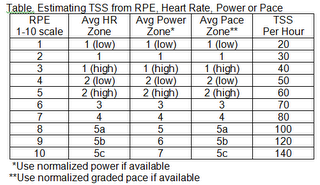Stress-Based Training - More
In my last post on this subject I described how you might go about setting the intensity and duration of your hardest ('breakthrough') workouts based on what you anticipate the intensity and duration of the race for which you are training will be. Jim Dicker wisely suggested that this process be based on an estimated Training Stress Score (TSS) instead of heart rate, power, pace or RPE. I agree. TSS will “normalize” the various scales allowing you to use a variety of data sources but only one 'scoring' system. 
Estimating TSS is not difficult. I’ve written on how to do this before. The table you see accompanying this post expands on the previous post’s table by including both power and pace. So with this table if you have a power meter on your road bike but only a heart rate monitor for your mountain bike, cyclocross bike or fixed gear, you can still produce a Training Stress Score for any bike workout, albeit estimated. The same would go for a triathlete who has a power meter on the bike with a GPS for running while using RPE only for swimming.
What I wrote about in the last blog on this topic remains the same. You start by estimating what the TSS of your next A-priority race will be. Then you design workouts that prepare you for that level of stress over the course of the season. In the early season workouts the stress should come primarily from low intensities and high durations. As the season’s training progresses the intensity advances to what it will be on race day as the duration decreases. Do these breakthrough workouts no more frequently than once weekly. Triathletes would generally be advised to include no more than two sports with breakthrough workouts in a week.
In the previous post I used the example of an athlete doing a 90-minute steady state race in which heart rate was anticipated to average zone 4. Using the accompanying table you can see that would produce an estimate of 80 TSS per hour – so a 120-TSS level of stress for a 1.5-hour race (1.5 x 80). The workout progression would be aimed at 120 TSS by varying duration and intensity just as I did in the previous example.
While helping to more accurately quantify your racing and training, using such a system also provides structure for your key breakthrough workouts, and serves as a series of tests of how you are progressing. Just be sure to make the progression from high-duration, low-intensity to high-intensity, low-duration a gradual shift over several weeks, if not months. Hurrying to get to the hardest workouts is very risky.
Some races will simply be too stressful to use this system. However, you could still prepare for portions of the race in the same way. For example, a 10-hour Ironman Triathlon may easily result in a combined TSS of 550. That’s huge. Trying to reproduce that in a single workout is simply not wise. So in such a situation you may do the swim, bike and run breakthrough workouts separately. It is possible, however, to combine portions of those sessions into ‘bricks.’
I understand this isn’t for everyone. This is what I do for the athletes I coach. It’s quite time-consuming, but beneficial, I believe. You’ve got to be a scientist-athlete to take your training to such a level. Few athletes are. But if you enjoy the details of training for competition then this may be for you.


2 Comments:
How does this apply to short duration events where total TSS is comparatively low, even though intensity may be high (say, cyclocross racing)? If we estimate TSS at 120/hour, it's still only 120 total for a cross race. To train for that, I understand that you will gradually work toward doing workouts at this stress level in a similarly short time - race simulations or equivalent intervals.
What about further out from the event, earlier in the season? Is there any value to doing workouts of higher TSS?
Jeff--Yes, there certainly is value in doing higher TSS workouts even if your event is relatively low total TSS. One of the issues for cyclists is the rate at which TSS is produced. I'll get at that in my next blog post.
Post a Comment
<< Home